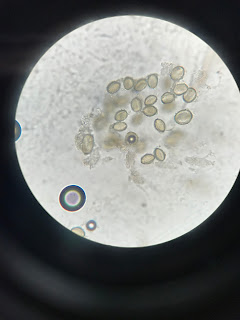My Story of the Seed group and I have been examining the reproductive process in the flowers created on one of the species of Brassica Oleracea plants. We have researched how the parts of the plant are being fertilized in order to reproduce. We learned of a few important reproductive organs in our flowers. The stamen is the male reproductive organ and the pistil is the female reproductive organ. It all starts at the stamen of the flower. At the end of the stamen is an anther. On the anther pollen is created through Meiosis. In order for reproduction to happen, the pollen made on the anther must find its way to the stigma. The stigma is the sticky end to the pistil which is the female reproductive organ of the flower. After the pollen has reached the stigma it is taken through the stalk of the pistil to the ovary at the base of the pistil. In the ovary the pollen germinates the ovules where the reproduction process begins.
Here is a picture of the whole flower we took from a species of Brassica Oleracea. You can see all petals, the anthers, the stamen, the stigma, and the top of the pistil. The ovary is hidden because it is at the bottom of the pistil(female reproductive organ).
This is a close up photo of the male reproductive anatomy of the flower. This part of the flower is called the stamen. The end of the stalk is called an anther. The anther is where the pollen is created through Meiosis. The pollen created on the end of the anther is the pollen that will eventually reach the female organ of the plant so that the plant can reproduce. The long stalk on the male reproductive organ is called the filament.
This is a close up of the female reproductive anatomy of the flower. This is called the pistil. As seen in the photo, the end of the pistil is larger than the rest of the stalk. That part is the stigma. The stigma is sticky. This allows the pollen from the stamen (male reproductive anatomy of the flower) to stick where it can germinate the female reproductive organ which starts the reproductive cycle. There are many ways for the pollen to reach the stigma. For example, wind can blow the pollen from the stamen to the stigma.
Here is a close up of the flower that has been completely stripped of all parts except the ovary. I have opened up the ovary to get a clear view of the ovules. The ovules are the tiny unfertilized green pea-like shapes. This is where the pollen from the stamen will eventually go to start the reproductive process.
EXTRA:
This is a magnified view of the pollen taken from one of the anthers. Done using a wet mount slide of pollen and a compound light microscope.





No comments:
Post a Comment